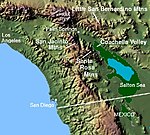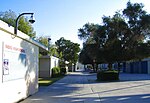The Coachella Valley ( koh-CHEL-ə, koh-ə-) is an arid rift valley in the Colorado Desert of Southern California in Riverside County. The valley may also be referred to as Greater Palm Springs and the Palm Springs Area due to the prominence of the city of Palm Springs and disagreement over the name Coachella. The valley extends approximately 45 mi (72 km) southeast from the San Gorgonio Pass to the northern shore of the Salton Sea and the neighboring Imperial Valley, and is approximately 15 mi (24 km) wide along most of its length. It is bounded on the northeast by the San Bernardino and Little San Bernardino Mountains, and on the southwest by the San Jacinto and Santa Rosa Mountains.
The valley is notable as the location of several wintertime resort cities, especially Palm Springs, that have become popular destinations for snowbirds. The valley is also known for a number of annual events, including the Coachella Valley Music and Arts Festival, the Stagecoach Country Music Festival, and the Riverside County Fair and National Date Festival, all held in Indio. Other events include the Palm Springs Modernism Week, Palm Springs International Film Festival, the ANA Inspiration and Desert Classic golf tournaments, and the Indian Wells Masters tennis tournament.
In addition to Palm Springs, the valley is home to the cities of Cathedral City, Coachella, Desert Hot Springs, Indian Wells, Indio, La Quinta, Palm Desert, and Rancho Mirage.
Summers in the valley are extremely hot and valley winters are mild. As such, the valley's population tends to fluctuate; from nearly 500,000 in April, to around 300,000 in July and August, to around 600,000 by January. It was estimated in 2013 that 3.5 million conventioneers and tourists visit the valley each year.The Coachella Valley connects with the Greater Los Angeles area to the west via the San Gorgonio Pass, a major transportation corridor, traversed by Interstate 10 and by the Union Pacific Railroad. The Coachella Valley is sometimes called the Desert Empire to differentiate it from the broader Inland Empire.








